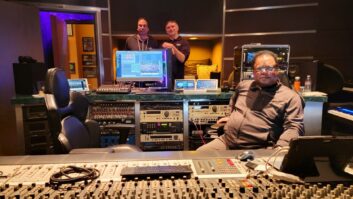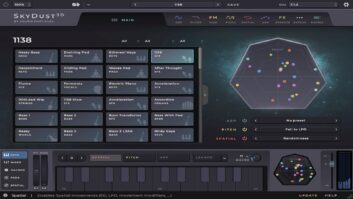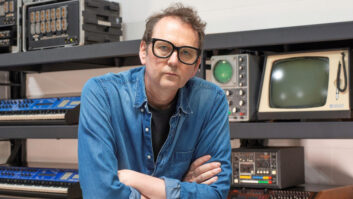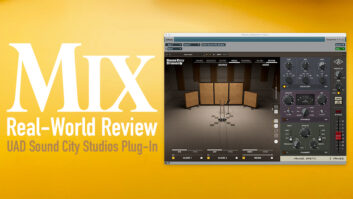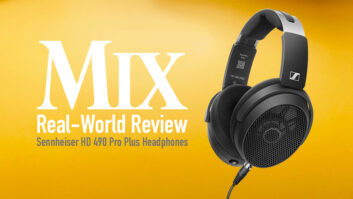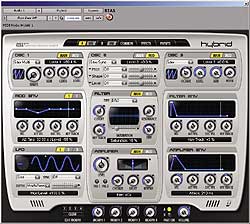
Main panel, showing oscillators, filters, effects and output level controls
Digidesign took longer than some DAW manufacturers to add software synthesizers to its product line, but when the company took the plunge, it did it right. Released first was Xpand! (free to Pro Tools owners), which comes with a large sound library and does multiple types of synthesis, but it’s not highly programmable; the user interface is limited to half-a-dozen macro knobs. Hybrid ($249) offers deeper programming features, but you don’t need to be a die-hard tweaker to use its elegant and satisfying factory presets. A lot of sound design work went into giving Hybrid the kind of basses, pads and keyboard comps that mainstream pop music producers are sure to love.
MEET THE HYBRID
Hybrid is a virtual analog synth. Although it isn’t multitimbral, its basic operating mode is dual, comprising a pair of three-oscillator voices side-by-side. The A and B parts can be layered, split or crossfaded. Each part is a complete synth, with multimode filter, envelopes, LFOs and effects. Each part has a step sequencer/arpeggiator, so catchy rhythmic effects can be dialed in easily. You can combine part A from one preset with part B from another preset for instant sound hybrids.
Oscillators 1 and 2 have seven different waveform modes, which include cross-modulation (equivalent to ring modulation), sync and a multi-sawtooth with detuning. Another mode provides access to a set of 100 digital wavetables. You can sweep through a wavetable using any modulator. The results, ranging from subtle animation to classic PPG-type effects, depend on the table you’ve chosen. The oscillators are anti-aliased to provide a clean high register and have a rich sound. Oscillator 3 is simpler: It offers only sawtooth, square and triangle waves, plus a square wave sub-oscillator and a noise amount, and has fewer modulation options.
The filter has 23 different modes, including lowpass and highpass with various numbers of poles, plus combinations such as band-reject with lowpass. The saturation stage in the filter is particularly fat and tactile-sounding. The filter has an audio rate FM input, which can use oscillator 3, noise or a mix of the two. The FM from oscillator 3 is limited by the fact that oscillator 3 does not have a pitch-modulation input, but FM can be used for roughing up the tone a bit. At high-resonance settings, Hybrid’s filter self-oscillates, so swirling FM sidebands are also easy to program.
Modulation starts with four envelopes and three LFOs. The filter envelope is an ADSR, but the amp envelope includes an extra decay stage; two general-purpose mod envelopes include a couple of extra stages. The LFOs can sync to the host’s tempo and have a start phase parameter and depth modulation. LFO 3 is polyphonic and can use rate modulation instead of depth modulation. These are great features.
The A and B parts each offer a pair of insert effects in series. Algorithms for these effects include all of the standard types, from plate and hall reverb through chorus and flange to distortion and bit reduction. In addition, A and B parts each have sends for the global chorus, delay and reverb effects. The manual would lead you to believe that the global effects are routed in parallel, but they’re actually in series. Careful listening tests reveal that each part has its own global chorus and delay, which share parameter settings.
MORPHOLOGY
The oscillator, filter and amplifier modules each have a set of three modulation inputs, which have bidirectional amount sliders. Each input can be assigned to any of the available destinations in the module; for instance, oscillator pitch, waveshape or level in the oscillators. All three inputs can be assigned to the same destination; you can modulate panning from three different sources at once.
Hybrid’s four Morph knobs can each be assigned to control any knob with any positive or negative amount. The Morph knobs can then be automated or assigned to the MIDI mod wheel, after-touch and so on. These knobs can transform the sound in expressive ways. Morphing can also be applied to envelope shapes.
STEPPIN’ OUT
The sequencer/arpeggiator is limited to 16 steps, but can perform a variety of sophisticated tricks. Instead of using the steps, you can load a factory phrase or import your own Standard MIDI file. Step sequences include two rows of controller data, the outputs of which can be attenuated with real-time MIDI modulation. Putting the sequencer in controller-only mode is a great way to superimpose a rhythmic filter pattern over the notes you’re playing from the keyboard. I had a lot of fun modulating waveshape from the sequencer controller outputs, creating lively Kraftwerk-like timbral patterns.
ENTER THE TONE ZONE
Hybrid is simply a great synthesizer, capable of both classic analog warmth and modern digital edge. Because it’s RTAS-only, non — Pro Tools users can only be jealous. There’s no free demo version, but you can rent Hybrid for two days for $10. It also comes free as part of the Music Production Toolkit for Pro Tools LE and M-Powered.
Digidesign, 650/731-6300, www.digidesign.com.
Jim Aikin is a regular contributor to Mix and Electronic Musician.

